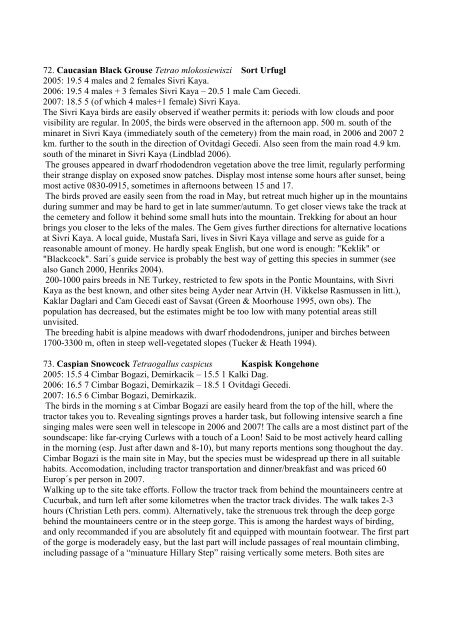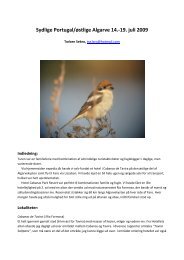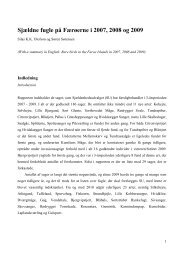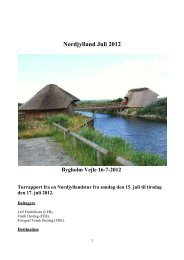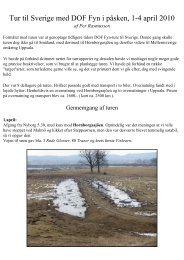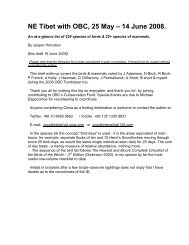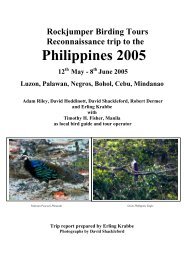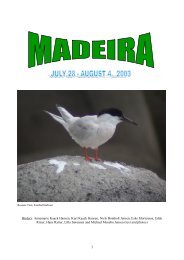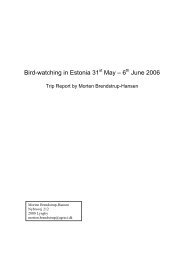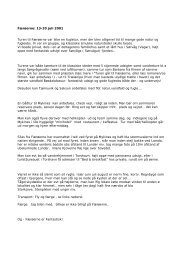TURKEY - a report from a birdwatching trip to Central ... - Netfugl.dk
TURKEY - a report from a birdwatching trip to Central ... - Netfugl.dk
TURKEY - a report from a birdwatching trip to Central ... - Netfugl.dk
Create successful ePaper yourself
Turn your PDF publications into a flip-book with our unique Google optimized e-Paper software.
72. Caucasian Black Grouse Tetrao mlokosiewiszi Sort Urfugl<br />
2005: 19.5 4 males and 2 females Sivri Kaya.<br />
2006: 19.5 4 males + 3 females Sivri Kaya – 20.5 1 male Cam Gecedi.<br />
2007: 18.5 5 (of which 4 males+1 female) Sivri Kaya.<br />
The Sivri Kaya birds are easily observed if weather permits it: periods with low clouds and poor<br />
visibility are regular. In 2005, the birds were observed in the afternoon app. 500 m. south of the<br />
minaret in Sivri Kaya (immediately south of the cemetery) <strong>from</strong> the main road, in 2006 and 2007 2<br />
km. further <strong>to</strong> the south in the direction of Ovitdagi Gecedi. Also seen <strong>from</strong> the main road 4.9 km.<br />
south of the minaret in Sivri Kaya (Lindblad 2006).<br />
The grouses appeared in dwarf rhododendron vegetation above the tree limit, regularly performing<br />
their strange display on exposed snow patches. Display most intense some hours after sunset, being<br />
most active 0830-0915, sometimes in afternoons between 15 and 17.<br />
The birds proved are easily seen <strong>from</strong> the road in May, but retreat much higher up in the mountains<br />
during summer and may be hard <strong>to</strong> get in late summer/autumn. To get closer views take the track at<br />
the cemetery and follow it behind some small huts in<strong>to</strong> the mountain. Trekking for about an hour<br />
brings you closer <strong>to</strong> the leks of the males. The Gem gives further directions for alternative locations<br />
at Sivri Kaya. A local guide, Mustafa Sari, lives in Sivri Kaya village and serve as guide for a<br />
reasonable amount of money. He hardly speak English, but one word is enough: "Keklik" or<br />
"Blackcock". Sari´s guide service is probably the best way of getting this species in summer (see<br />
also Ganch 2000, Henriks 2004).<br />
200-1000 pairs breeds in NE Turkey, restricted <strong>to</strong> few spots in the Pontic Mountains, with Sivri<br />
Kaya as the best known, and other sites being Ayder near Artvin (H. Vikkelsø Rasmussen in litt.),<br />
Kaklar Daglari and Cam Gecedi east of Savsat (Green & Moorhouse 1995, own obs). The<br />
population has decreased, but the estimates might be <strong>to</strong>o low with many potential areas still<br />
unvisited.<br />
The breeding habit is alpine meadows with dwarf rhododendrons, juniper and birches between<br />
1700-3300 m, often in steep well-vegetated slopes (Tucker & Heath 1994).<br />
73. Caspian Snowcock Tetraogallus caspicus Kaspisk Kongehøne<br />
2005: 15.5 4 Cimbar Bogazi, Demirkacik – 15.5 1 Kalki Dag.<br />
2006: 16.5 7 Cimbar Bogazi, Demirkazik – 18.5 1 Ovitdagi Gecedi.<br />
2007: 16.5 6 Cimbar Bogazi, Demirkazik.<br />
The birds in the morning s at Cimbar Bogazi are easily heard <strong>from</strong> the <strong>to</strong>p of the hill, where the<br />
trac<strong>to</strong>r takes you <strong>to</strong>. Revealing signtings proves a harder task, but following intensive search a fine<br />
singing males were seen well in telescope in 2006 and 2007! The calls are a most distinct part of the<br />
soundscape: like far-crying Curlews with a <strong>to</strong>uch of a Loon! Said <strong>to</strong> be most actively heard calling<br />
in the morning (esp. Just after dawn and 8-10), but many <strong>report</strong>s mentions song thoughout the day.<br />
Cimbar Bogazi is the main site in May, but the species must be widespread up there in all suitable<br />
habits. Accomodation, including trac<strong>to</strong>r transportation and dinner/breakfast and was priced 60<br />
Europ´s per person in 2007.<br />
Walking up <strong>to</strong> the site take efforts. Follow the trac<strong>to</strong>r track <strong>from</strong> behind the mountaineers centre at<br />
Cucurbak, and turn left after some kilometres when the trac<strong>to</strong>r track divides. The walk takes 2-3<br />
hours (Christian Leth pers. comm). Alternatively, take the strenuous trek through the deep gorge<br />
behind the mountaineers centre or in the steep gorge. This is among the hardest ways of birding,<br />
and only recommanded if you are absolutely fit and equipped with mountain footwear. The first part<br />
of the gorge is moderadely easy, but the last part will include passages of real mountain climbing,<br />
including passage of a “minuature Hillary Step” raising vertically some meters. Both sites are


